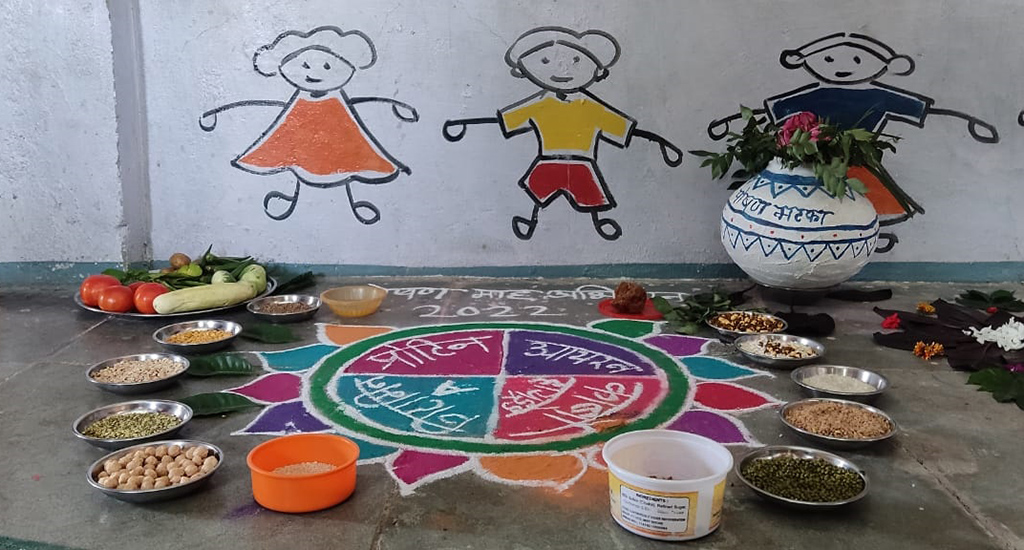
Poshan Maah – eat nutritious, eat local
September’s Poshan Maah (nutrition month) helps development professionals drive home the importance of eating locally-sourced, nourishing food to eradicate malnutrition through discussions and games.

September’s Poshan Maah (nutrition month) helps development professionals drive home the importance of eating locally-sourced, nourishing food to eradicate malnutrition through discussions and games.
On a warm summer day, I met Surekha, a young mother, at an anganwadi (rural child care centre) in Chhindwara district, Madhya Pradesh. Surekha had recently given birth to her third baby. After resting for a week, she was back in the cotton fields, working as a daily wage labourer. Her palms and feet were cracked and soiled with remnants of mud when she entered the anganwadi during her lunch break.
While talking to her, I learned that all her three children fall into different stages of malnutrition, including her newborn who weighed only 2 kilos, was weak and malnourished.
The anganwadi worker (AWW) had identified Surekha’s two older children to suffer from severe acute malnutrition (SAM) and the third child from moderately acute malnutrition (MAM) after weighing them.
I saw the confusion on Surekha’s face while listening to the AWW. She was trying hard to make sense of the terms SAM and MAM. But to this mother who struggles every day to make ends meet, it seemed like correcting an invisible illness and a futile effort.

Surekha’s story mirrors the fact that the burden of malnutrition in India is unevenly distributed and is directly associated with gender, caste and class inequalities.
Malnutrition in tribal areas
In the tribal areas of Madhya Pradesh (MP), where The Antara Foundation (TAF) mainly works, issues like early pregnancy, severe anaemia, home delivery and malnutrition coexist.
Madhya Pradesh is one of the states with a high prevalence of anaemia and stunted children, according to the National Family Health Survey-5 (NFHS-5).
The houses in these areas are often dispersed and located far away on hilltops, with limited access to healthcare services. Consequently, the vulnerable sections of society, especially women and children, bear a greater risk of being malnourished.

Many studies have shown that undernutrition during childhood deprives the body of essential nutrients, leading to low immunity, making many susceptible to diseases.
This becomes an intergenerational cycle. When an undernourished girl reaches reproductive age (still undernourished), she inevitably gives birth to an undernourished baby. The risk also expands to child and maternal mortality.
Debunking traditional myths
A few days ago, Sukhwanti, an anaemic mother, delivered a baby boy. Filled with joy, her family performed all the rituals and made janam ghutti (a concoction of cow’s milk and herbs), an age-old practice to protect the newborn.
During the post-natal period, it is a common practice to restrict the woman’s diet to one meal a day. The belief is that if a woman eats more, the child will not be able to digest the milk and will cause bloating.
I visited Sukhwanti along with the ‘AAA’ – accredited social health activist, anganwadi worker and auxiliary nurse midwife (ASHA, AWW, ANM). Though she had been advised to exclusively breastfeed the baby, her family was against this and believed that the baby must be fed cow’s milk and honey. We counselled them on the importance of exclusive breastfeeding.
At TAF, we prioritise home visits to such households, along with the healthcare workers and their supervisors. We also monitor and analyse data on pregnant women, births and malnourished children, to identify those at high risk and ensure end-to-end follow-ups.
Observing nutrition month
As part of September’s Poshan maah (nutrition month) the state government issues guidelines on the effective implementation of Poshan Abhiyaan, a central government initiative to improve the nutritional status of India’s mothers and children.

As malnutrition is a multi-dimensional issue, Poshan Abhiyaan encompasses both community participation and community ownership to solve the nutritional challenges in a village where the involvement of all stakeholders is vital.
The healthcare workers at the village level reach out to various age groups of the village, including men.
Nutrition pots of local foods
To build ownership within the communities, public awareness rallies are held in the village. In addition to the nutrition-related activities at the anganwadi, an innovative element is the poshan matkas (pots).
Each day the women bring a handful of locally available nutritious grains, vegetables and fruits to the AWC. The AWWs place them in beautifully decorated pots, while discussing the nutritional value of each food item.
These pots are then given to the women for their own use, helping them realise the importance of dietary diversity that can be achieved in their village. As this community-based initiative is budget-friendly and uses local produce, it can easily be replicated.
Learning the fun way
During the nutrition month, the AWWs also arrange and decorate the anganwadis with flowers and colourful rangolis for officials to see. The enthusiasm and zeal with which some of them work is unparalleled.

During field visits, our team actively participates in the daily planned activities at the anganwadi by bringing in innovative games like spinner wheel games, card games, jigsaw puzzles and pocket charts, on topics like micronutrient deficiency, benefits of breastfeeding and child danger signs.
These interactive games help build a rapport with the communities and enable them to pass on important information, while also having fun. As part of the abhiyaan we organise screening camps to identify SAM and MAM children and increase the participation of such families in the day-to-day activities.
Families, including men, are encouraged to maintain good nutrition.
Not only does the abhiyaan create awareness at the grassroots level, it embraces the locally available resources in India’s rural areas to tackle the most pressing issue of malnutrition.
During Nutrition Month, there is additional focus on creating awareness about nutrition through locally available food (Photo courtesy The Antara Foundation)
Nandita Arora is working with The Antara Foundation as Program Officer in Chhindwara district, Madhya Pradesh.